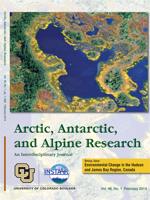Macrofossil analysis of the peat and topographic surveys of two palsa fields (Fields 3 and 4) within a permafrost peatland located in subarctic Québec was conducted to trace the factors that contributed to their differential development. The two palsa fields are visibly different in terms of their geomorphology, ecology, and hydrology. According to our results, the evolution of the two fields was largely synchronous in terms of the respective trophic conditions. Moreover, the climate certainly played a significant role in the evolution of this ecosystem. For example, the cooling of the Neoglacial period would have favored the ombrotrophication of both sites, whereas the Little Ice Age conditions would have contributed to palsa formation. Despite the synchronous changes within the two fields, significant differences were also noted. These include the rate of peat accumulation, the number of species found in the peat monoliths, and the presence or absence of forest cover during the ombrotrophic phase. The topography of the underlying substrate would also have influenced the hydrological conditions. For example, a light slope toward the northwest engendered a faster trophic impoverishment in Field 4. In addition, streaming water in Field 3 favored the preservation of wet and rich conditions that triggered the following changes: more diverse vegetation, the significant accumulation of peat, and the formation of higher palsas.
How to translate text using browser tools
1 February 2014
Differential Development of Two Palsa Fields in a Peatland Located Near Whapmagoostui-Kuujjuarapik, Northern Québec, Canada
Marie-Ève Fillion,
Najat Bhiry,
Mustapha Touazi





